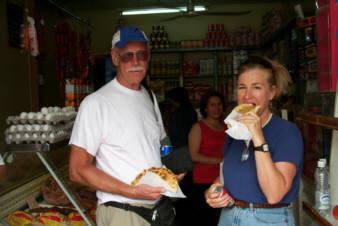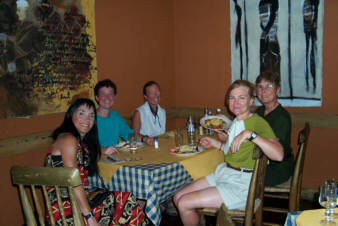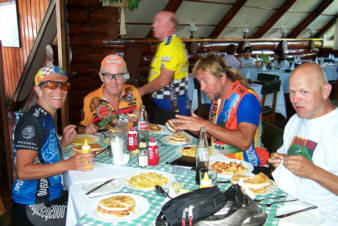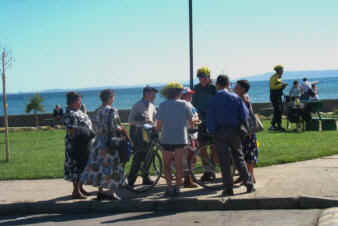

Page 10
Chile ![]()
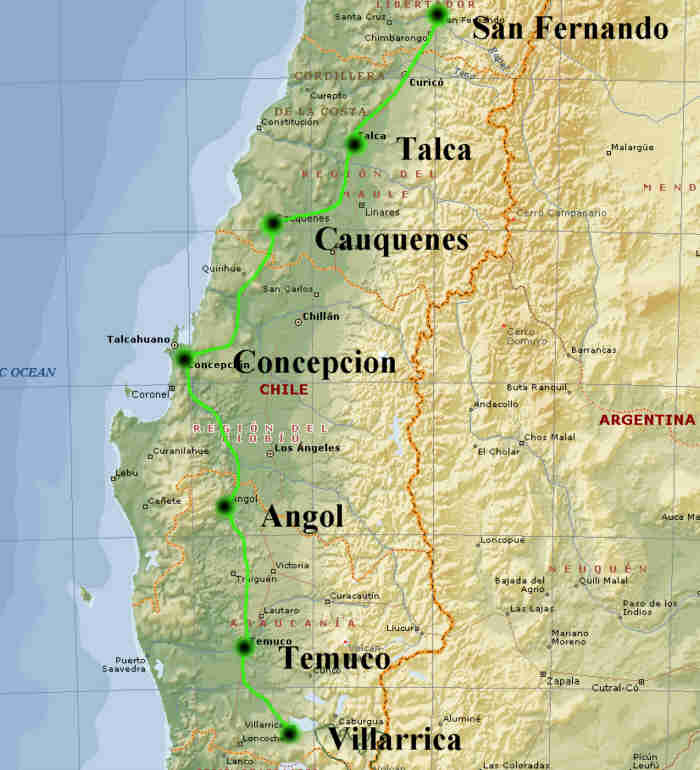
Day 34-39
2/3-7/2000
San Fernando to Talca
Talca
to Cauquenes
Cauquenes to Concepcion
Concepcion
to Angol
Angol
to Temuco
Temuco
to Villarrica
Hola! I knew what would happen and it did. With all this cycling and camping I have not had the time or energy for correspondence. Someone summed up these last days when he said, "All we do is get up in the morning and rush to reach the next soccer field where we will camp for the night." The Chilean soccer fields that we have seen are not lovely green grassy areas with hot and cold running water and toilets that flush in the locker rooms. No way! They are largely dirt surfaces with rocks, trash, and weeds interspersed; the water in the showers is most probably cold and the showers may or may not drain, there may be toilets but there are no seats and there certainly is never any toilet paper. Outdoors there are most likely no chairs or benches or shelter. One stands in line for meals and then stands to eat unless supple enough to sit comfortably on the ground. There have been some exceptions. In Temuco we camped at the municipal sports complex and there was lovely green grass for our tents and there were tables and chairs for seated outdoor dining which worked fine for the evening meal but in the morning it was raining and it still is. Rain is predicted for the next several days. We are all soaking wet.
There have been seven hard days of cycling and camping since Santiago, most of the time cycling on Highway 5 and camping on soccer fields. I have to admit that the days have sort of run together in my memory, so I will skip the day by day details and stick with general impressions and memorable moments. Chile is beautiful. The countryside is rolling hills, lots of hills, and headwinds too but this far at least lots flatter than anyone dared hope. We have seen the Andes but just from a distance. They are spectacular. One that has been in view for days is a perfect cone shape and snow covered. Others are cones that have lost their tops in volcanic eruptions. I am hoping the weather will clear so that we can see more of them.
Most of the countryside that we have passed is cultivated. The fields are green or golden depending on the crop. It is summer here and crops are being harvested. There are roadside stands selling the bountiful harvests including watermelon, cantaloupe, honeydew, corn, tomatoes, onions, grapes, peaches, and nectarines. We have seen fields of grain and sunflowers, and thousands of acres of tree farms of both pine and eucalyptus trees. Trees of many varieties grow everywhere separating the fields, clustered around homes, alongside the roads. It would appear that the soil is fertile and the rainfall adequate to sustain the trees and wildflowers. Blue, yellow, and white flowers bloom alongside the roads and the wild blackberry bushes are loaded with luscious berries. Farming and logging are both important industries. On Day 36 enroute to Concepcion, we rode through Tome, a coastal fishing community. Fishing is another important industry, the fishermen bring in a good variety of fish. Salmon was the only fish I recognized and it seems to be the most popular. I've seen it on menus several times and ordered it for lunch once. It was delicious.
The food is a surprise. I had expected it to be similar to Spanish or Mexican food, but it doesn't resemble either. Barbecued meat is a treat and we've had pork chops, chicken, and beef steak. Most often though the meat served is boiled beef, an enormous chunk of meat which must weigh a half a pound or more. With that we have been served white rice au jus, cooked vegetables including string beans, peas, and corn, and a salad of fresh tomatoes and onions, and sliced cucumbers. The tomato and onion salad is delicious. Salt has been the only seasoning used on any of the food except for vinegar and oil on the tomatoes and onion salad.
The same bread is served at every meal, it resembles a hockey puck in shape and density, and varies in size from regular hamburger bun size to jumbo size. It is hard to chew and at best has the flavor of saltless soda crackers. Sandwiches are made with it too. Some people actually like it and we have had it so regularly now that we all miss it if there isn't enough to go around. It seems every country has its own unique bread. In Mexico it was very thin and delicate but chewy hot flour tortillas cooked on a griddle (not at all like those available in packages in U.S. grocery stores), in Costa Rica it was rather dry corn tortillas, not all that tasty actually.
How lucky we are to be in Chile when the fruit is ripe and the vegetables are ready. Fruit and vegetables along with the hockey puck bread have been a feature at breakfast and dinner. Breakfast may include fruit, yogurt, lunchmeat or salami, cheese, jello, pudding, scrambled eggs with chopped ham, hockey pucks, and if we are really lucky there may be butter, marmalade, or a thick sweet caramel spread. Even the hockey puck bread tastes delicious when spread with that. But the first time I saw the eggs I thought there had to be a mistake. Of course our food is served from huge pots since there are so many of us so when I saw those nearly liquid scrambled eggs I thought they must have run out of time to cook them but no, come to find out, they are served that way day after day. Perhaps that dish is meant to be an egg soup rather than scrambled eggs. I haven't tried them so I don't know whether they are cooked long enough even to be warm. People say they are very salty. The food often is salted but that is the only seasoning used. There is never pepper available and apparently no spices are used in the cooking. I need to ask Anthony, a rider from Chile, or Raphael, the doctor about it. Perhaps they have purposely left out the seasonings to accommodate their international guests.
In Santiago breakfast was only hockey puck sandwiches made of a very thin slice of ham or cheese. There was no butter or dressing of any kind. We had to tear off a bite with our teeth and then chew and chew and chew. But we did have very generous servings of fruit including wedges of watermelon and honeydew melon, clusters of grapes and sliced peaches. Dinner is usually beef, pot roasted or boiled and rice, or spaghetti. Of course the hockey puck bread is served and also large servings of cooked vegetables including string beans, corn, peas, carrots, and potatoes. If there is dessert it is ice cream. The Chileans love ice cream. It is sold in tiny shops everywhere.
The Chilean people outside of Santiago have been friendly, curious, and helpful. They shout to us in Spanish to wish us a good journey and sometimes they say 'I love you' in English and blow kisses. Groups of children and families gather by the roadside to watch us pass, to give us "high fives", flowers, candy, bottled water and even little notes. People are always wanting to talk to us, to learn who we are and what we are doing and it is so disappointing to them and to me when I can't respond with much more than 'no habla espanol'. It has been the rare Chilean I have met that speaks any English at all. I am very sorry that I didn't make time to learn some Spanish before this trip. Chile is a beautiful and a friendly country to visit but learning a little Spanish beforehand would have greatly enhanced my understanding and enjoyment and made it possible to communicate with the people which is the best part of any trip at least for me.
On second thought eating and enjoying the local cuisine is probably the best part of a trip for me. I have been succeeding enormously at that and consequently, in spite of all the exercise, I am not getting slimmer. The men are however and any potbellies are diminishing. The vegetarian women are having trouble getting adequate nutrition, some are losing weight and are low on energy. Special food was supposed to be provided for them but it has seldom been food that would provide the protein they need, just more vegetables or maybe pasta.
There has been much intestinal distress and sickness among us with perhaps 100 or more at any one time afflicted. Raphael, the doctor now traveling with us, has offered advice. The sick people should avoid fruit and dairy products. Everyone should be careful what they eat. He mentioned strawberries in particular as a food to avoid, and it was just the night before that CJ had come into camp with a big bag of local strawberries to share with everyone. As much as I love strawberries, I ate only one and I have been avoiding lettuce like the plague too. Raphael said that the crops are sometimes watered with sewer water and that of course could be a source of the sickness. The water throughout Chile is said to be safe to drink but I have avoided that too whenever possible. I am happy to report that I am one of the few who have not been sick. Somehow those poor suffering sick folks struggle along and in 2 to 4 days usually recover. Most are too sick to ride so are carried along in the Sag wagon. Sometimes they stay behind in a hotel until recovered and then go by bus to our current location.
This trip is hard on most everyone in one way or another. Some miss their families too much, some can't cycle the miles, some don't like the way things are organized, lots find fault with the route, etc., etc. But most are 'getting a grip' and finding ways to cope and be comfortable. We have lost perhaps 13 riders who have given up and gone home.
I am having the time of my life! No way am I going to give up! I love the adventure of it and the luxury of every breakfast and dinner being set before me. Adjusting to life after Odyssey could be tougher even than after Aramco (and houseboys). I am a happy camper!
Adios, Alice
Chile
![]()
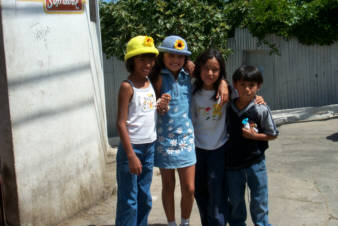
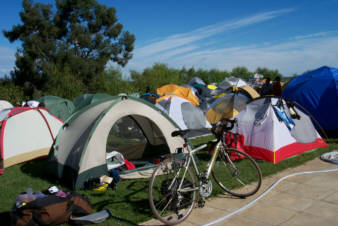
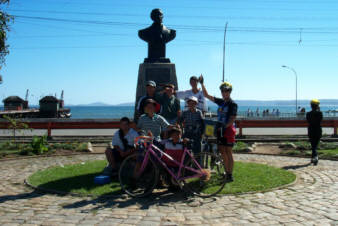
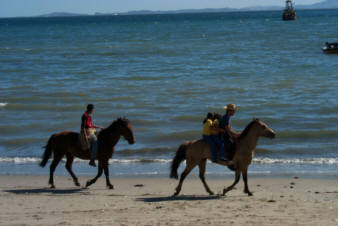
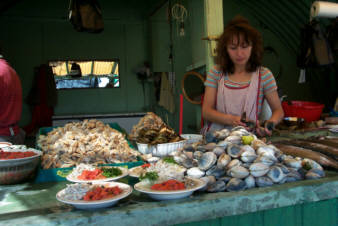
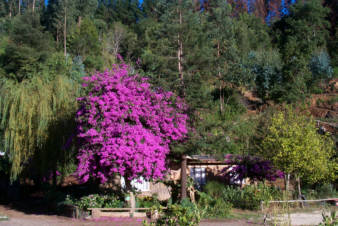
 Odyssey Riders and Staff
Odyssey Riders and Staff
